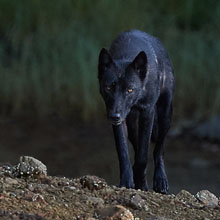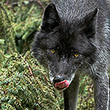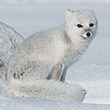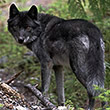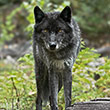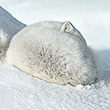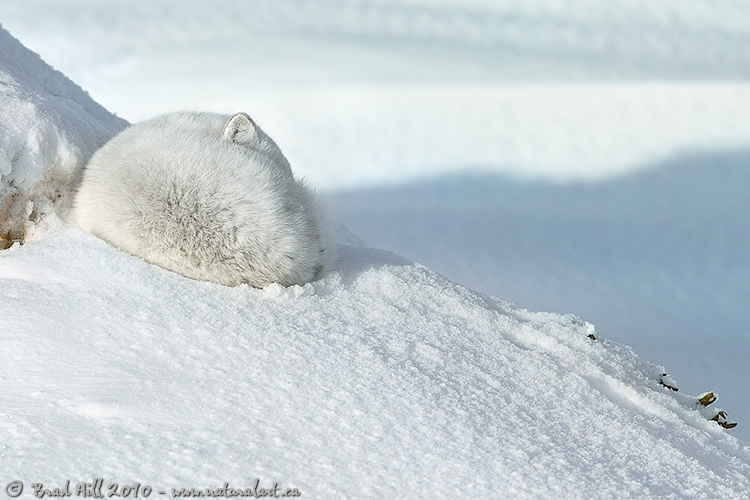
Availability: Undetermined - Enquiries?
In the Field
White-on-White: Arctic Camouflage. Cape Churchill, MB, Canada. October 25, 2004 (image processed in early 2010).
As a biologist I find the many adaptations of animals to their environment completely captivating. This is a shot of an Arctic Fox doing its level best to look like a chunk of snow. And, in my opinion, it's doing a darned good job! Between the white colouration of the fox, and its behaviour of curling up to sleep (which also, of course, functions to keep it warm), this diminutive carnivore was incredibly hard to spot. We were actually extremely close to it before we spotted it, and only did so because for a moment it raised its head to look around before going back into this position (and it was the movement which attracted our eye).
Probably the biggest challenge in capturing this image was initially spotting the fox. As it turned out, the fox just happened to lay down in a spot that was almost tailor-made for producing a compelling image! Not only was the light perfect, but the ridge it was laying on provided a strong diagonal to work with AND virtually every natural line in the image lead to the fox! Whoever arranged this scene for us knew something about eye flow and composition! Thanks - your effort is greatly appreciated!
Behind the Camera
One Arctic Fox - Chilled on Ice? Cape Churchill, MB, Canada. October 25, 2004 (image re-processed in early 2010).
Digital Capture; Compressed RAW (NEF) format; ISO 200.
Nikon D2H with Nikon 200-400 mm f/4G ED-IF AF-S VR lens @ 400 mm (600 mm EFL) supported on bean bag. VR turned to "On" and in "Normal" mode.
1/2000s @ f5.6; no exposure compensation from matrix-metered exposure setting.
At the Computer
One Arctic Fox - Chilled on Ice? Cape Churchill, MB, Canada. October 25, 2004 (image re-processed in early 2010).
RAW Conversion, including first-pass sharpening, using Phase One's C1 Pro 5.0.2. Two raw conversions at different exposure settings to balance final exposure. Raw conversions at -0.67 stops (to reduce brightness of sunlit snow in background) and +0.25 stops (to retrieve shadow detail on portions of the fox).
All further digital correction on 16-bit TIFF file using Adobe's Photoshop CS4 and Light Craft's LightZone 3.8.5. Photoshop adjustments included compositing (layer and masking) of 2 exposure variants, selective colour saturation and desaturation, and selective sharpening for web output. Final tone tweaking and adjustments using the Tonemapper/Re-light tool of LightZone.
Conservation
One Arctic Fox - Chilled on Ice? Cape Churchill, MB, Canada. October 25, 2004 (image re-processed in early 2010).
Ten percent of the revenue generated by this image will be donated to the Yellowstone to Yukon Conservation Initiative.
Species Status in Canada*: Not "Endangered" or "Threatened".
In Canada the Arctic Fox (Alopex lagopus) is not listed as an endangered species and, as such, is not afforded any legal protection (it is still considered a relatively important commercial species in Canada, although low fur prices in recent years have reduced the occurrence of hunting of this species). Recent documented northward expansion of the range of the Red Fox (which is a primary predator of the Arctic Fox) may prove to be threat to Canada's Arctic Foxes in the future. It is possible this is an indirect consequence of global warming.
The Arctic Fox is threatened with extinction in Sweden, Finland, and mainland Norway. As such, both the foxes and their dens have been legally protected for decades (since 1928 in Sweden, 1930 in Norway, and Finland since 1940).
The Yellowstone to Yukon (Y2Y) Conservation Initiative seeks to ensure that the world-renowned wilderness, wildlife, native plants, and natural processes of the Yellowstone to Yukon region continue to function as an interconnected web of life, capable of supporting all of its natural and human communities, for current and future generations.
*as determined by COSEWIC: The Committee on the Status of Endangered Wildlife in Canada


















